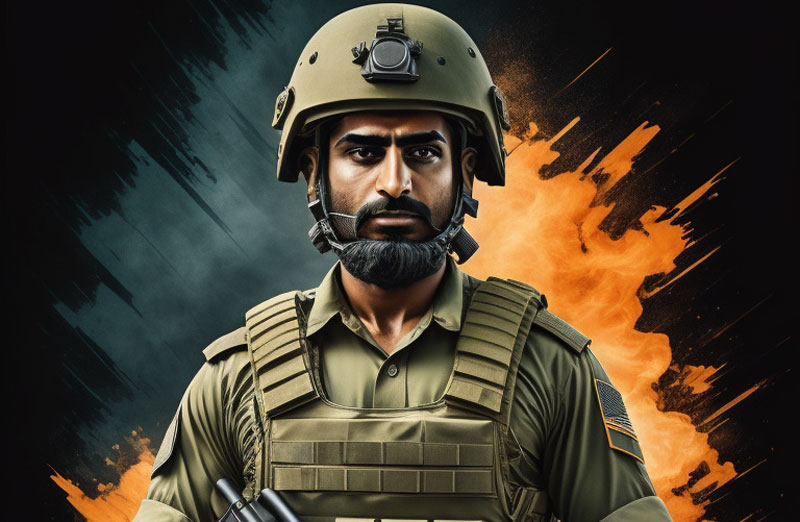As technology leaps, government must invest in state-of-the art protective gear
Mohammed Asif Khan
In 2020, the Comptroller and Auditor General (CAG) of India raised concerns with the government, highlighting significant deficiencies and notably insufficient reserves of specialised winter clothing, snow goggles, multi-purpose boots and related equipment. These shortages were particularly acute for troops deployed in high-altitude areas such as Siachen, Ladakh and Doklam.

The audit report underscored the impact of delayed procurements, emphasising how essential clothing was in short supply due to delays in the acquisition process. According to a NITI Aayog estimate from 2020, the tri-services—Army, Navy, and Air Force—along with Central Armed Police Forces (CAPFs) such as Border Security Force (BSF), Central Reserve Police Force (CRPF), Central Industrial Security Force (CISF) and police, required a minimum of 3,00,000 bullet-proof jackets. Additionally, in late 2022, the Indian Army identified a crucial need for an additional 80,000 ballistic helmets to fortify its personnel against the escalating threat of high-velocity bullets.
Beyond the numerical aspect, the qualitative dimensions of this requirement become apparent through the lens of recent historical events. Instances of armed forces and state police engaging in combat operations without essential body armour and safety gear underscore the critical deficiency in protective equipment.
For instance, the aftermath of the 26/11 attacks in Mumbai brought to light glaring inadequacies, particularly in the bullet-proof jackets worn by security personnel. The Pradhan Inquiry Commission revealed the shocking reality that some jackets were outdated, incapable of withstanding grenade attacks, and, most alarmingly, purchased defective.
There are also different protective requirements for different forces. In 2020, the Indian Army wrote to the Ministry of Defence (MoD) demanding that the CAPFs refrain from wearing combat uniforms because they closely resembled what the Indian Army wears during combat operations thus leading to confusion amongst civilians between the army and police force.
Bulletproof vests and helmets serve as critical protective gear for both paramilitary and police forces, yet their requirements differ based on the nature of their operations. Paramilitary forces often face higher-calibre threats, including military-grade weapons, necessitating bulletproof vests designed to resist rifle rounds and provide comprehensive coverage to the torso, sides and back. These vests are crafted for enhanced mobility and flexibility in dynamic, tactical situations. In contrast, police forces predominantly encounter lower-calibre threats from handguns, leading to the development of vests focused on protecting vital organs with a balance between mobility and ballistic resistance.
Similarly, the design and functionality of helmets also vary. Paramilitary helmets are engineered to offer heightened ballistic protection, including resistance against rifle rounds and shrapnel. They may feature a more robust design, covering more of the head, and could be slightly heavier to ensure increased protection.
Paramilitary helmets often include specialised features like attachment points for accessories such as night-vision goggles or communication devices, catering to the diverse needs of combat scenarios. On the other hand, police helmets are typically lighter in design, prioritising comfort during extended use, covering the top of the head, and emphasizing simplicity for compatibility with standard police equipment in urban environments. These distinctions underscore the tailored approach to meeting the unique safety requirements of paramilitary and police personnel.
The need for different equipment standards between the army and the CAPF stems from the contrasting nature of their roles and operational contexts. The army, geared towards national defence in diverse and potentially intense warfare scenarios, requires versatile protective gear capable of withstanding a range of threats, including heavy artillery. In contrast, CAPF, engaged in internal security and law enforcement, faces different challenges in urban or border regions, necessitating equipment tailored to handle lower-intensity threats and crowd control situations.
The variation in threat perceptions, operational environments and budget constraints contributes to the distinct standards for protective gear, ensuring that each force is adequately equipped for its specific responsibilities.
Industrial licenses have been issued to 15 companies for manufacturing bullet-proof jackets in the country with a production capacity of over 10,00,000per annum to meet the domestic and export requirements. Yet, India struggles to equip its security forces adequately.
Leap of Technology
The advancements required in bulletproof vests go beyond bullet proofing. Comfort and ergonomics are crucial considerations. The lighter composite materials make these vests significantly easier to wear for extended periods, reducing fatigue and improving situational awareness. Additionally, modularity allows for attaching night vision goggles, communication headsets and visors, adapting to diverse scenarios, from close-quarter firefights to covert night operations.
In 2021, the Defence Research and Development Organisation (DRDO) developed a lightweight Bullet-Proof Jacket (BPJ) weighing around 9 kilograms, meeting the Indian Army's requirements. The Front Hard Armour Panel (FHAP) was tested at the Terminal Ballistics Research Laboratory (TBRL), Chandigarh, and met relevant Bureau of Indian Standards. The jacket was developed by the Kanpur-based Defence Materials and Stores Research and Development Establishment (DMSRDE), a DRDO laboratory.
In 2022, Tata Advanced Systems Limited (TASL) secured a contract to supply 10,000 bullet-proof jackets for the Indian Air Force (IAF). The lightweight bullet-resistant body armour is expected to replace bulky and heavy jackets slowly being phased out from the entire armed forces.
Reports have indicated that the Indian Air Force (IAF) aims to provide its Garuda Commando Force with lighter jackets that offer resistance against close combat weapons. The objective is to ensure that these jackets do not impede swift movement of the commandos during operations.
You must be logged in to view this content.

